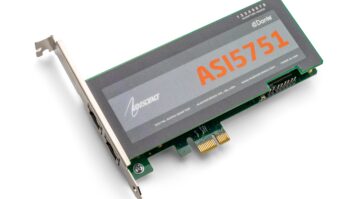As I write, the depleted remnants of a tropical storm are finally moving out of the area, leaving behind several inches of rain, some flooding and scattered power outages.
Not nearly as bad as Katrina or Ivan, mind, but we’ve had non-stop rain for days now. This was the latest event in what has turned out to be a very hot, humid and stormy season.
WYDE(FM)’s main antenna recently had been damaged by lightning. But after replacing the top bay, we were still getting a lot of reflected power, so we had no choice but to take the antenna apart one section at a time.
When the crew got to bay No. 6, they found that the bullets had cooked off, burning the line for several feet in each direction. Molten copper had dripped down into the line below the burnout as well.
Not good. We had no choice but to drop the entire antenna to the ground for a complete cleanout and rebuild.
We ordered Teflon insulators and bullets from ERI — I had some Dielectric inner sections on hand — and got to work.
The biggest problem — once again — was the humidity. Each night we’d store everything in the air-conditioned transmitter building and all that metal would get cold. As soon as we’d move it outside, moisture would condense with a vengeance.
(click thumbnail)Fig. 1: Burned-out bullet at bay No. 6 in WYDE’s antenna.We had water streaming everywhere. When you add in the fact that we were sweating like mad, it was just a glorious thing. We went through several rolls of shop towels and a half gallon of denatured alcohol just keeping everything clean and dry while we reassembled it.
This is something the books and engineering papers don’t adequately cover, even though it definitely falls under the heading of “things you need to know as a broadcast engineer.” The references just say helpful things like “the inside of the line must be absolutely clean and dry” and “don’t get finger oil, grime or sweat on the connectors.”
What they don’t tell you is how to accomplish this when it’s 95 degrees at 85 percent relative humidity! I’d like to share a few tips, most of which come from this most recent experience with WYDE.
A little is too much
Of course, the references are absolutely right: Even a small amount of moisture in an air-dielectric transmission line can cause corrosion, signal losses and arcing.
It’s also true that no line is perfectly sealed, especially not as it ages and the seals become less flexible. Then you add the real-world component. One part of a line that’s in direct sunlight could be extremely hot (I’ve measured 180 degrees myself) while 50 feet away, a section that’s in shade is much cooler (same case, I measured 80 degrees — a 100 degree difference).
This causes uneven expansion and contraction, exacerbating the problem. Plus, a section that’s extremely hot at midday will cool down after dark, so you could have a change of over 100 degrees in a matter of hours, further stressing the line.
To help keep moisture out, the standard practice is to pressurize the line with dry gas; typical values are 3–5 PSIG with a dew point of at least –20 degrees (the lower, the better).
Many engineers just use commercially-bottled nitrogen and a regulator. This has the virtue of simplicity, but it also has drawbacks. You have to pay for regular deliveries and the tanks are bulky and heavy. The worst downside is that if Bubba uses your tower for target practice and punctures a line, that nitrogen will quickly be exhausted. A pump-driven system that uses free air might be able to hold enough positive pressure on that line to keep out the rain until repairs can be started.
You shouldn’t just use a stock two-gallon compressor from the local auto parts store to fill a line. The air around us, even in a sealed building with HVAC, will have water vapor in it. Standard HVAC units aren’t designed to remove all moisture, because people will complain if the air is too dry. This isn’t a problem at the home or office, but that air simply isn’t suitable for pressurizing a transmission line.
While an air-conditioned transmitter building will certainly help, you have to take an extra step to make that free air really dry. That’s where a dehydrator comes in.
Dehydration
The simplest dehydrator pushes air at relatively low pressure through a desiccant chamber and then into the line. This works fine in many cases, though you do need to monitor the desiccant and replace or recharge it when it becomes moist. Typically, the desiccant (or a window filled with indicating grains) will change color when it’s time to service the unit.
(click thumbnail)Simplified functional diagram of the Andrew MT-2000Be prepared for when the HVAC fails, too! As Fay swept through our area, the air conditioner died at another station, WXJC(AM). The emergency ventilation kicked on, pulling thousands of cubic feet of warm, moisture-saturated air into the building. WXJC’s dehydrator decided to top off the transmission lines right about then … and the desiccant was fouled in a single fill.
To be safe, especially if you live in a humid climate like ours, you really need to remove as much bulk moisture as possible before the air even gets to the dehydrator.
As it turns out, the Andrew MT-2000 that we use at WYDE(FM) has given me some ideas.
That site has 1,300 feet of 5-inch coax and 1,000 feet of 4-inch rigid line. Even with that industrial-strength dehydrator doing the work, it still takes hours to fill those lines. Fortunately, this thing doesn’t use a desiccant chamber; it has a membrane-type dryer. But after looking closely, I realized that the bulk of the moisture removal happens before it gets to the membrane.
Fig. 2 is a simplified diagram that shows how Andrew has combined a trick from industrial pressurization with that membrane to produce 2 SCFM at a dew point of –50 degrees.
Any time you pressurize air, the temperature and the dew point (the temperature at which water vapor condenses) will go up. Most simple desiccant-type dehydrators operate at relatively low pressures, so this isn’t an issue with them. But once you get above 30 PSIG (approximately three atmospheres), the rise becomes significant.
Here’s the trick as shown in that diagram. If you cool the hot air from the compressor while maintaining that high pressure, the water vapor condenses into a liquid that can easily be removed with a simple moisture separator or coalescing filter. A large workshop compressor might have a big aftercooler with a fan; the MT-2000 gets by just fine with a simple passive radiator. The coalescing filters do the heavy lifting and the membrane dryer just does the “finish” work, lowering the final output to a dew point of at least –50 degrees.
How effective is this? While I was purging and refilling WYDE’s line with our current horrible humidity, the coalescing filters (the MT- 2000 actually has two of them, in series) got waterlogged more than once. Had all of that moisture made it to the membrane, it probably would have become fouled.
That gave me some ideas for my other dehydrators that I hope to report on later. Simply putting a coalescing filter in front of a low-pressure pump won’t really help, but I’m looking at a way to duplicate this effect with all of our dehydrators here.
Practical purging
When installing a new line, or after repairs to an existing one, you have to rid it of all moisture, dirt and contaminants.
While doing the assembly, use denatured alcohol and plenty of dry rags to wipe all surfaces thoroughly. With rigid line, take one of the inners and make a swab of shop towels; push it through several times. Then wipe the inner. Once you’re done and everything has been put together, it’s time to do the final purge.
The standard method is to fill the line, drain it, refill it and repeat several times. Jim Coleman of Southern Broadcast Services showed me a better way several years ago (and he says that he, in turn, learned it from an engineer named Dean Shepherd).
He recommends that you vacuum the line. At very low pressure, water boils at room temperature. When you refill the line with clean, dry air, it’ll take longer (because you have to add one atmosphere of pressure plus the 3–5 pounds that you normally want), but trust me, this works — especially in the real world here in Alabama, where just popping a line for a minute to check a connector can result in a lot of moisture sneaking in.
You can buy a standard vacuum pump, or you might modify your dehydrator to do this. Go to Lowe’s or Home Depot and buy some ball valves and extra fittings so that you can quickly switch your transmission line to the inlet or outlet. But be careful not to leave the pressure gauges on your transmission line connected when you vacuum; it’ll “suck the needle backwards,” which will make the gauge inaccurate at best, and could even destroy it in the worst case. (Speaking from sad experience — you can profit from my dumb mistake.)
How low can you go with the pressure? Jim (and common sense) says that you shouldn’t do this with thin-walled waveguide; a hard vacuum will cause it to collapse. But with most any standard 50 ohm coax or hard line, you can vacuum that line as low as your equipment will take it.
As Jim says, let it run until the pump starts growling! If you don’t have a vacuum gauge, monitor the output fitting with a moistened finger: when the line is evacuated, no air will be coming out of the pump. Do not apply power to the line while it’s under vacuum.
You want the pressure as low as possible to get a low boiling point, which will help remove even tiny droplets of moisture that might have lodged in the little nooks and crannies. Once you’ve drained the line as low as you can get it, wait a few hours for the temperature to stabilize, then refill it with clean, dry air. If you can’t get a hard vacuum (or close to it), repeat this process a couple of times.














